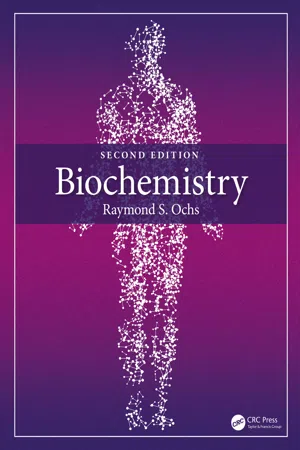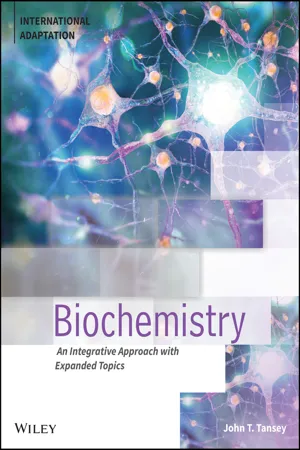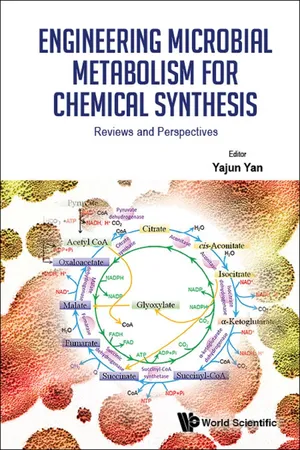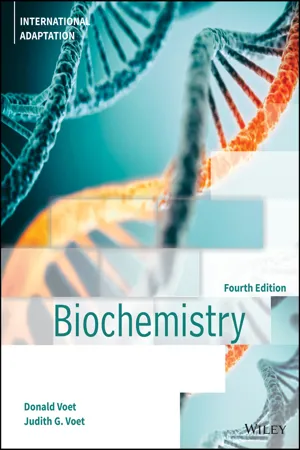Biological Sciences
Krebs Cycle
The Krebs Cycle, also known as the citric acid cycle, is a series of chemical reactions that occur in the mitochondria of cells. It plays a crucial role in the process of cellular respiration, where it helps to generate energy in the form of ATP. Through a series of steps, the cycle oxidizes acetyl-CoA, producing NADH, FADH2, and ATP.
Written by Perlego with AI-assistance
Related key terms
Related key terms
1 of 4
Related key terms
1 of 3
10 Key excerpts on "Krebs Cycle"
- eBook - ePub
- Raymond S. Ochs(Author)
- 2021(Publication Date)
- CRC Press(Publisher)
10 The Krebs CycleThirty years after discovering glycolysis, investigators had identified several intermediates involved in the complete oxidation of pyruvate to CO2 . However, the route itself remained a mystery until Hans Krebs found that pyruvate entered into a reaction with a four-carbon intermediate, producing citric acid, a six-carbon tricarboxylic acid. He also showed that after a series of reactions, the same four-carbon intermediate was regenerated; in other words, the pathway was a cycle. The Krebs Cycle, now considered a landmark study, was published in 1937 as the citric acid cycle (Box 10.1). The result was not well-received, however, for reasons that we explore in this chapter. In fact, many called the route the “Krebs Cycle” not as praise but to suggest that it was just one investigator’s belief. The pathway’s cyclic nature was tentatively accepted, but only the part involving tricarboxylic acid intermediates other than citrate. The pathway was thus referred to as the tricarboxylic acid cycle. Today, the route is well established (Figure 10.1 ), and all three names are used. We choose the Krebs Cycle, as it is pithier, vindicates the findings of a great biochemist, and conforms to the tradition of other named highlights of biochemistry, such as Michaelis–Menten kinetics, the Lineweaver–Burke plot, and the Calvin cycle.FIGURE 10.1 Reactions of the Krebs Cycle. The cycle intermediates and their structures are shown as a cycle; acetyl-CoA is the substrate. Cofactors are shown in blue.10.1 A Cyclic Pathway
A series of enzymatic reactions in a cyclic pathway is analogous to the individual steps in an enzymatic reaction. Consider two examples of enzyme reaction mechanisms involved in the formation of ethanol from pyruvate by yeast, drawn in Figure 10.2 as cyclic processes. The first reaction (Figure 10.2a) shows pyruvate decarboxylase (E1) and its other enzyme forms, E1:pyruvate and E1:acetaldehyde, as cycle intermediates. Pyruvate enters the cycle, and the products, CO2 and acetaldehyde, leave. For the second reaction (Figure 10.2b), the cycle intermediates are alcohol dehydrogenase (E2), E2:acetaldehyde and E2:ethanol. Acetaldehyde and NAD+ - eBook - ePub
Biochemistry
An Integrative Approach with Expanded Topics
- John T. Tansey(Author)
- 2022(Publication Date)
- Wiley(Publisher)
The chemical bonds of acetyl-CoA are still energetically rich. The acetyl group of acetyl-CoA is ultimately oxidized in the citric acid cycle into CO 2, and the electrons obtained in these reactions are used to reduce the electron carriers NAD + and FAD to NADH and FADH 2. The electrons are used in subsequent reactions in the electron transport chain to generate a proton gradient, which subsequently drives ATP production in a process known as oxidative phosphorylation. A second and equally important function of the citric acid cycle is to serve as a central metabolic hub. Many molecules, such as the carbon skeletons of amino acids, are also metabolized through the citric acid cycle. FIGURE 7.1 Citric acid cycle. The citric acid cycle (also known as the tricarboxylic acid cycle or the Krebs Cycle) is the central hub of metabolism. While it oxidizes the carbons of acetyl-CoA to CO 2, it captures the electrons as NADH and FADH 2 for use in electron transport. Various pathways feed into and out of the cycle, linking central metabolism with other pathways. (Source: Karp, Cell and Molecular Biology: Concepts and Experiments, 7e, copyright 2013, John Wiley & Sons. This material is reproduced with permission of John Wiley & Sons, Inc.) 7.1.1 There are eight reactions in the citric acid cycle The citric acid cycle begins with a condensation of acetyl-CoA with oxaloacetate, generating the six-carbon tricarboxylic acid citrate. Citrate contains a tertiary alcohol that cannot be oxidized. In the next reaction, citrate is isomerized to the secondary alcohol isocitrate by the enzyme aconitase, and the isocitrate is then oxidized to α-ketoglutarate by isocitrate dehydrogenase. In this process, a molecule of CO 2 is lost, and electrons from isocitrate are captured by NAD +, generating NADH/H +. Recall that in these reactions the equivalent of a hydride ion is transferred to NAD + forming NADH. The proton is released as a second reaction product and maintains charge balance - eBook - ePub
New and Future Developments in Microbial Biotechnology and Bioengineering
Microbial Secondary Metabolites Biochemistry and Applications
- Vijai G. Gupta, Anita Pandey(Authors)
- 2019(Publication Date)
- Elsevier(Publisher)
Chapter 13Citric Acid Cycle Regulation: Back Bone for Secondary Metabolite Production
Punit Kumar1 and Kashyap Kumar Dubey2 ,1 Microbial Process Development Laboratory, University Institute of Engineering and Technology, Maharshi Dayanand University, Rohtak, Haryana, India,2 Bioprocess Engineering Laboratory, Department of Biotechnology, Central University of Haryana, Mahendergarh, Haryana, IndiaAbstract
The citric acid cycle (CAC) is recognized as the central hub of a large number of metabolic pathways. It is commonly known as the Krebs Cycle or tricarboxylic acid cycle. It starts from the reaction between oxaloacetate and actyl CoA. It is an enzyme-controlled metabolic cycle involved in metabolizing of biomolecules. The main purpose of the CAC is to furnish the energy demand of all types of cells but its intermediates are used as precursors in the biosynthesis of metabolites, thus different metabolic pathways are joined with the CAC making a network of metabolic pathways. The utilization of CAC flux in energy generation or in the biosynthesis of a metabolite depends on the energy requirements of the cell and physiological conditions. The control and regulation of the CAC reactions have great significance in cell metabolism and the utilization of flux in biomolecule biosynthesis. Researchers are using CAC manipulations (metabolic engineering) to enhance the yield of desired metabolites by altering the flux of specific intermediates or the overexpression of enzymes to catalyze more product formation. - No longer available |Learn more
MCAT Biochemistry Review 2024-2025
Online + Book
- (Author)
- 2023(Publication Date)
- Kaplan Test Prep(Publisher)
MCAT Biochemistry Review—don’t they produce energy without oxygen? While glycolysis does not depend on oxygen, it only yields a net 2 ATP per molecule of glucose, which is not nearly enough to maintain the body’s energy requirements. This brings us to two of the most tested topics on the MCAT: the citric acid cycle and oxidative phosphorylation.In this chapter, we’ll take a close look at what’s gained when the products of glycolysis and other derivatives of metabolic pathways enter the citric acid cycle. We’ll also look at how this process is regulated with regard to the substrates, products, and reactions involved. Lastly, we’ll observe what happens when this cycle’s products undergo oxidative phosphorylation, with particular emphasis on how the electron transport chain facilitates the process and the ATP that is yielded.10.1 Acetyl-CoA
LEARNING OBJECTIVES
After Chapter 10.1, you will be able to:- Detail four potential energy sources for the synthesis of acetyl-CoA
- Identify the major inputs and outputs through the pyruvate dehydrogenase complex
The citric acid cycle, also called the Krebs Cycle or the tricarboxylic acid (TCA) cycle, occurs in the mitochondria. The main function of this cycle is the oxidation of acetyl-CoA to CO2 and H2 O. In addition, the cycle produces the high-energy electron-carrying molecules NADH and FADH2 . Acetyl-CoA can be obtained from the metabolism of carbohydrates, fatty acids, and amino acids, making it a key molecule in the crossroads of many metabolic pathways and a highly testable compound.Methods of Forming Acetyl-CoA
Recall from Chapter 9 of MCAT Biochemistry Review that after glucose undergoes glycolysis, its product, pyruvate, enters the mitochondrion via active transport and is oxidized and decarboxylated. These reactions are catalyzed by a multienzyme complex called the pyruvate dehydrogenase complex, which is located in the mitochondrial matrix. As we take a deeper look at the enzymes that make up this complex, as well as the substrates and products of their reactions, it is helpful to follow the carbons in the molecules. For example, the three-carbon pyruvate is cleaved into a two-carbon acetyl group and carbon dioxide. This reaction is irreversible, which explains why glucose cannot be formed directly from acetyl-CoA. In mammals, pyruvate dehydrogenase complex is made up of five enzymes: pyruvate dehydrogenase (PDH), dihydrolipoyl transacetylase, dihydrolipoyl dehydrogenase, pyruvate dehydrogenase kinase, and pyruvate dehydrogenase phosphatase. While the first three work in concert to convert pyruvate to acetyl-CoA, the latter two regulate the actions of PDH. Figure 10.1 shows the overall reaction for the conversion of pyruvate to acetyl-CoA. The reaction is exergonic - eBook - ePub
- R. Michael Akers, D. Michael Denbow(Authors)
- 2013(Publication Date)
- Wiley-Blackwell(Publisher)
There are two critical physiological points to the Krebs Cycle reactions. The first is that some ATP is produced directly via substrate-level phosphorylation of ADP similar to that which occurs in glycolysis. The second and most important is that with each turn of the cycle, reduced forms of the coenzymes NAD and flavin adenine dinucleotide (FAD) are produced. When enzymes of the electron transport chain, also located in the mitochondria, subsequently oxidize these molecules, this yields the energy for synthesis of the vast majority of ATP that can be created from overall catabolism of glucose. We have provided only a skeleton outline showing the names of the intermediates of the Krebs Cycle reactions and locations of specific events. Remember that each molecule of glucose generates two molecules of pyruvate so there are two turns of the cycle for each glucose molecule. Fig. 3.7. Outline of the Krebs Cycle reactions. Since each glucose molecule yields two pyruvate molecules (in the presence of oxygen), this allows two turns of the cycle. With each turn, two carbons are removed from the citric acid (six carbons) by decarboxylation reactions; this leads to the production of the 4-carbon intermediate oxaloacetic acid. Oxaloacetic acid initiates the cycle as it condenses with acetyl-CoA (two carbons) to produce citric acid. Although the pyruvate that entered the mitochondria had three carbons, remember that two carbons were lost as CO 2 to generate acetyl-CoA. Although not “officially” part of the Krebs Cycle, at the time of decarboxylation of the pyruvate, NAD + is simultaneously reduced. Four additional oxidations by the removal of hydrogen atoms occur during the cycle. This yields four molecules of reduced coenzymes (three NADH + H + and one FADH 2). One ATP molecule is made with each turn of the cycle due to the initial creation of GTP, which then provides the phosphate group to make ATP from ADP - eBook - ePub
Engineering Microbial Metabolism for Chemical Synthesis
Reviews and Perspectives
- Yajun Yan(Author)
- 2017(Publication Date)
- WSPC (EUROPE)(Publisher)
Figure 2.1 ). Citric acid cycle is also known as tricarboxylic acid (TCA) cycle because the first acid in this cycle has three carboxyl groups. In 1953, Hans Adolf Krebs won the Nobel Price for clarifying the mechanism of citric acid cycle. In memory of Hans Adolf Krebs, this cycle is called Krebs Cycle as well. In this chapter, we will introduce the fundamentals of citric acid cycle and its metabolic engineering applications in recent years.Figure 2.1. The schematic figure of citric acid cycle. This figure shows the changes in the number of carbon atoms in one cycle. Citric acid cycle is a metabolic hub of sugar, lipid, and amino acid in organisms. This cycle provides various skeletal structure of molecules for life.2.2.Preparation of Citric Acid Cycle
Glucose is converted into pyruvate via glycolysis. Then pyruvate reacts through two different pathways depending on the conditions. Under anaerobic conditions, pyruvate generates either lactic acid or ethanol in different organisms. Under aerobic conditions, pyruvate is converted into acetyl coenzyme A (acetyl-CoA) and subsequently decomposes into water and carbon dioxide by oxidation.Figure 2.2. Citric acid cycle, reverse citric acid cycle, and glyoxylate cycle. The black arrows show the preparation of citric acid cycle. The blue lines indicate citric acid cycle. The yellow arrows represent glyoxylate cycle. The purple texts indicate the enzymes involved in citric acid cycle. The red texts show the energy-rich molecules.As shown in Figure 2.2 , pyruvate is converted into acetyl-CoA with pyruvate dehydrogenase complex acting as a catalyst. This enzyme complex is a highly ordered and integrated containing three enzymes — pyruvate dehydrogenase component, dihydrolipoyl transacetylase, and dihydrolipoyl dehydrogenase — and uses thiamine pyrophosphate (TPP), lipoamide, CoA, NAD+ , and FAD as cofactors. Each enzyme in pyruvate dehydrogenase complex has its independent active site that can catalyze reactions sequentially. By the catalysis of these three enzymes, pyruvate generates one molecular carbon dioxide and reassigns one high-transferpotential electron to NAD+ - eBook - ePub
Strelkauskas' Microbiology
A Clinical Approach
- Beatrix Fahnert, Phoebe Lostroh(Authors)
- 2023(Publication Date)
- Garland Science(Publisher)
2 is also given off during this cycle, and each step in the cycle is controlled by a specific enzyme. During the Krebs Cycle, three important things occur:- Carbon is oxidized to CO2 .
- NAD+ or FADH are oxidized to NADH or FADH2 . These carriers subsequently take the electrons to the electron transport chain (described below).
- Energy is captured and stored when ADP (adenosine diphosphate) is converted to ATP.
The Electron Transport ChainElectron transport is the cellular process in which electrons are transferred to an extracellular final electron acceptor. In aerobic metabolism, that final electron acceptor is oxygen. In anaerobic metabolism, the final electron acceptor is an inorganic molecule such as nitrate (NO3 – ), nitrite (NO2 – ), or sulfate (SO4 2– ). During electron transport, hydrogen atoms are transferred to NAD+ carrier molecules, which transfer the hydrogen atoms to proteins; these proteins are found in a precise arrangement in the microbial cell membrane or in the inner membrane of the mitochondria in eukaryotic cells (Figure 3.9).The transfer of hydrogen atoms from one molecule to another in the electron transport chain involves oxidation and reduction reactions. Each member of the chain becomes reduced as it picks up electrons. When it gives the electrons to the next molecule in the chain, it becomes oxidized and the accepting molecule becomes reduced (see Figure 3.9 ). From the catabolism of a single molecule of glucose, 10 pairs of electrons are transported to the electron transport chain by NADH and an additionalAn illustration of the electron transport chain with oxygen as the final electron acceptor. This process is where the majority of ATP is produced during cellular respiration. In this series of steps, electrons and protons (H+ ions) are passed between the intermediates in a sequence of redox reactions. In this case, the final electron acceptor is molecular oxygen, which then uses the acquired electrons and protons to form water, H2 O.Figure 3.9 - eBook - ePub
- Donald Voet, Judith G. Voet(Authors)
- 2021(Publication Date)
- Wiley(Publisher)
19 Citric Acid Cycle1 Cycle OverviewA. Reactions of the CycleB. Historical Perspective2 Metabolic Sources of Acetyl-Coenzyme AA. Pyruvate Dehydrogenase Multienzyme Complex (PDC)B. The Mechanism of Dihydrolipoyl DehydrogenaseC. Control of Pyruvate Dehydrogenase3 Enzymes of The Citric Acid CycleA. Citrate SynthaseB. AconitaseC. NAD+ -Dependent Isocitrate DehydrogenaseD. α-Ketoglutarate DehydrogenaseE. Succinyl-CoA SynthetaseF. Succinate DehydrogenaseG. FumaraseH. Malate DehydrogenaseI. Integration of the Citric Acid Cycle4 Regulation of The Citric Acid Cycle5 The Amphibolic Nature of The Citric Acid Cycle6 The Glyoxylate CycleIn this chapter we continue our metabolic explorations by examining the citric acid cycle, the common mode of oxidative degradation in eukaryotes and prokaryotes. This cycle, which is alternatively known as the tricarboxylic acid (TCA) cycle and the Krebs Cycle, marks the “hub” of the metabolic system: It accounts for the major portion of carbohydrate, fatty acid, and amino acid oxidation and generates numerous biosynthetic precursors. The citric acid cycle is therefore amphibolic, that is, it operates both catabolically and anabolically.We begin our study of the citric acid cycle with an overview of its component reactions and a historical synopsis of its elucidation. Next, we explore the origin of the cycle's starting compound, acetyl-coenzyme A (acetyl-CoA), the common intermediate formed by the breakdown of most metabolic fuels. Then, after discussing the reaction mechanisms of the enzymes that catalyze the cycle, we consider the various means by which it is regulated. Finally, we deal with the citric acid cycle's amphibolic nature by examining its interrelationships with other metabolic pathways.1 Cycle Overview
See Guided Exploration 18: Citric acid cycle overview The citric acid cycle (Fig. 19-1 - eBook - ePub
Biochemistry Explained
A Practical Guide to Learning Biochemistry
- Thomas Millar(Author)
- 2018(Publication Date)
- CRC Press(Publisher)
9 The Tricarboxylic Acid Cycle In this chapter you will learn:- where the TCA cycle takes place.
- the relationship of aspar tic acid and glutamic acid and the compounds of the TCA cycle oxaloacetate and α-ketoglutarate
- where the acetyl group of acetyl-CoA originates
- how pyruvate is transferred across the mitochondrial membrane and converted to acetyl-CoA
- in which parts of the cycle FADH2 , NADH, GTP and CO2 are produced
- the compounds and enzymes of the cycle
- how the TCA cycle is controlled
- The parts of the TCA cycle used for amino acid synthesis or breakdown, the part used for fat synthesis, and the part used for energy production
- The conversion of oxaloacetate to phosphoenolpyruvate for gluconeogenesis
Location and purpose of the tricarboxylic
The tricarboxylic acid (TCA) cycle is one of the most fascinating and central cycles in biochemistry. It is also known as Kreb’s cycle, and the citric acid cycle. This cycle takes place in mitochondria. It has 2 main functions: to shuffle carbon skeletons, and to break down some compounds for generation of energy. The energy obtained is captured by reducing NAD and FAD to NADH and FADH2 respectively. To obtain full usage of the energy generated in this cycle, NADH and FADH2 are processed by another pathway (oxidative phosphorylation) where their energy is converted to ATP.MAJOR POINT 43 : The TCA cycle takes place inside mitochondria.For me, the most fascinating part of this cycle is that different tissues use different parts of the cycle depending upon the primary function of that tissue. Muscle and brain, which require large amounts of energy, use the TCA cycle to produce high energy compounds such as ATP and NADH. On the other hand, the liver, which requires little energy, uses the TCA cycle to shuffle carbon skeletons to form amino acids and fats. Fat cells primarily use the TCA cycle to channel the carbon atoms of glucose to form (unfortunately) fat. - eBook - ePub
- Pascal Leclair(Author)
- 2023(Publication Date)
- CRC Press(Publisher)
5 The Energy of Cells Part I Glycolysis and the Krebs CycleDOI: 10.1201/9781003379058-5Glycolysis comes from the Greek meaning “splitting of sugar” and it is a process whereby sugars get broken down in a chain of events that leads to the production of energy which cells can use to power cellular processes. As we will see in this chapter, in the absence of oxygen, the metabolism of sugar yields lactic acid in multicellular organisms and ethanol in fermenting yeast, but only a small amount of energy can be produced from this pathway and energy stocks are rapidly depleted. However, in presence of oxygen, pyruvic acid is produced instead, and this molecule is further processed in a second pathway, the Krebs Cycle (also called the tricyclic or citric acid cycle) where most of the energy used by cells is produced, with CO2 and water as by-products. The complexity of these pathways—multi-step processes which include more than two dozen enzymes, most of which acting sequentially on the breakdown of carbohydrates—led to much confusion in the first quarter of the 20th century (and in the writing of this chapter …). As such, to fully understand the metabolism of sugars into usable energy, we must first go back to the process of fermentation.We saw in Chapter 3 that the Buchner brothers had put to rest the vitalistic versus enzyme theory of fermentation in the late 1800s, which resulted in the realization that cellular processes were performed not by an intrinsic force but rather by a complement of enzymes that catalyze chemical reactions. Specifically, they had ascribed the process of fermentation to one enzyme, zymase, which was found to be essential for fermentation, but could not bring it about on its own. They subsequently found that zymase was dependent on a second enzyme, which was named, aptly enough, co-enzyme.1
Index pages curate the most relevant extracts from our library of academic textbooks. They’ve been created using an in-house natural language model (NLM), each adding context and meaning to key research topics.
Explore more topic indexes
Explore more topic indexes
1 of 6
Explore more topic indexes
1 of 4









